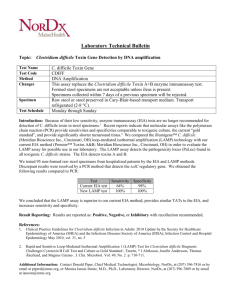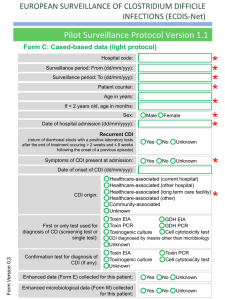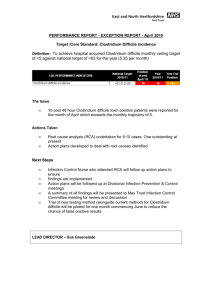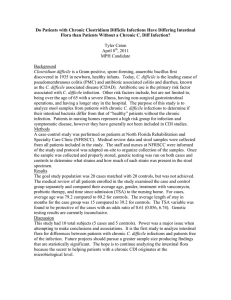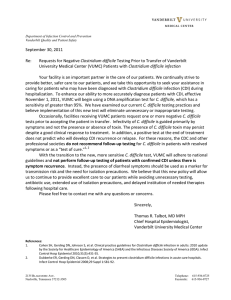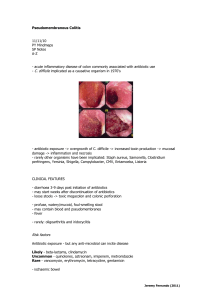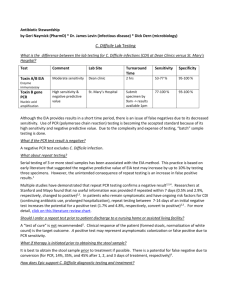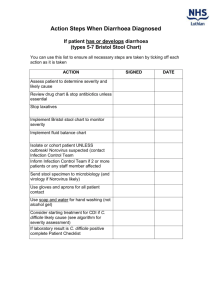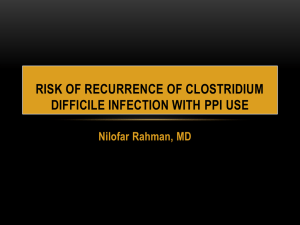Clostridium difficile Testing Information Introduction
advertisement
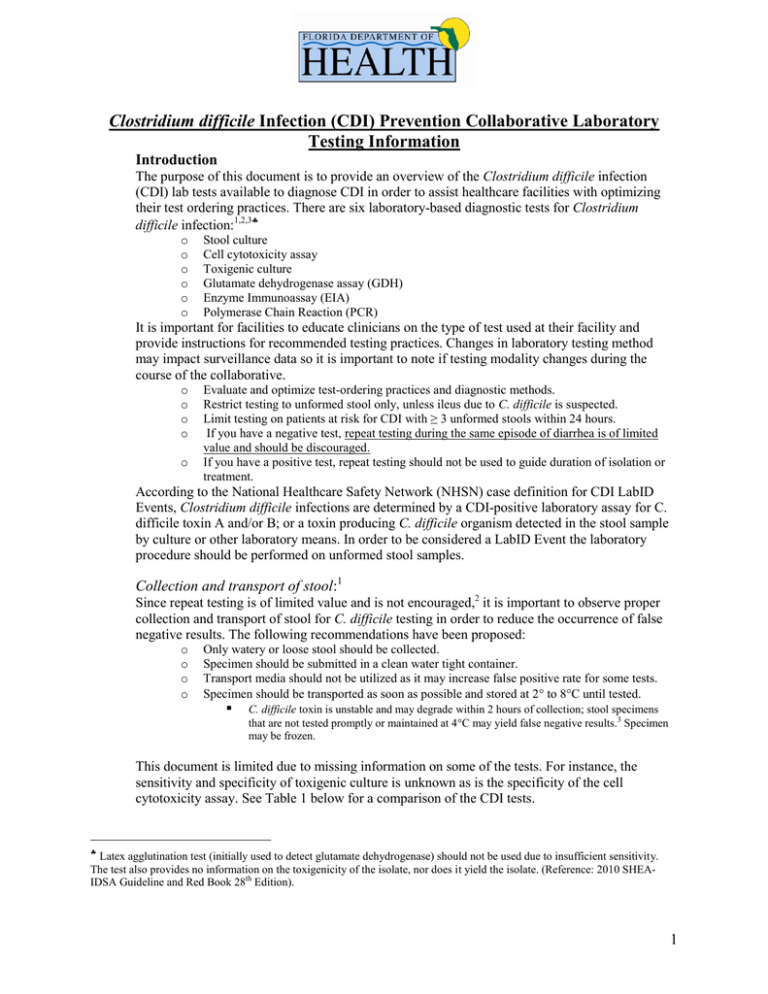
Clostridium difficile Infection (CDI) Prevention Collaborative Laboratory Testing Information Introduction The purpose of this document is to provide an overview of the Clostridium difficile infection (CDI) lab tests available to diagnose CDI in order to assist healthcare facilities with optimizing their test ordering practices. There are six laboratory-based diagnostic tests for Clostridium difficile infection:1,2,3 o o o o o o Stool culture Cell cytotoxicity assay Toxigenic culture Glutamate dehydrogenase assay (GDH) Enzyme Immunoassay (EIA) Polymerase Chain Reaction (PCR) It is important for facilities to educate clinicians on the type of test used at their facility and provide instructions for recommended testing practices. Changes in laboratory testing method may impact surveillance data so it is important to note if testing modality changes during the course of the collaborative. o o o o o Evaluate and optimize test-ordering practices and diagnostic methods. Restrict testing to unformed stool only, unless ileus due to C. difficile is suspected. Limit testing on patients at risk for CDI with ≥ 3 unformed stools within 24 hours. If you have a negative test, repeat testing during the same episode of diarrhea is of limited value and should be discouraged. If you have a positive test, repeat testing should not be used to guide duration of isolation or treatment. According to the National Healthcare Safety Network (NHSN) case definition for CDI LabID Events, Clostridium difficile infections are determined by a CDI-positive laboratory assay for C. difficile toxin A and/or B; or a toxin producing C. difficile organism detected in the stool sample by culture or other laboratory means. In order to be considered a LabID Event the laboratory procedure should be performed on unformed stool samples. Collection and transport of stool:1 Since repeat testing is of limited value and is not encouraged,2 it is important to observe proper collection and transport of stool for C. difficile testing in order to reduce the occurrence of false negative results. The following recommendations have been proposed: o o o o Only watery or loose stool should be collected. Specimen should be submitted in a clean water tight container. Transport media should not be utilized as it may increase false positive rate for some tests. Specimen should be transported as soon as possible and stored at 2 to 8C until tested. C. difficile toxin is unstable and may degrade within 2 hours of collection; stool specimens that are not tested promptly or maintained at 4C may yield false negative results.3 Specimen may be frozen. This document is limited due to missing information on some of the tests. For instance, the sensitivity and specificity of toxigenic culture is unknown as is the specificity of the cell cytotoxicity assay. See Table 1 below for a comparison of the CDI tests. Latex agglutination test (initially used to detect glutamate dehydrogenase) should not be used due to insufficient sensitivity. The test also provides no information on the toxigenicity of the isolate, nor does it yield the isolate. (Reference: 2010 SHEAIDSA Guideline and Red Book 28th Edition). 1 Test Highlights Table 1. Comparison of CDI Lab Tests. Additional Information Toxigenic Culture4 *Gold standard -This test can be utilized on its own. Polymerase Chain Reaction (PCR)2 Enzyme Immunoassay (EIA)1,3,4 -High sensitivity -High specificity -Labor intensive -Slow turn-around time -Rapid -Expensive -Sensitivity of 94.4% -Specificity of 96.3% -Sensitivity of 63-94% -Specificity of 75-100% -Rapid -Inexpensive -Easy to use -Due to slow turn-around time, if there is a high suspicion of CDI, empiric treatment may be called for to avoid delays in therapy. -This test can be utilized on its own. -Some EIA kits only test for antigenic response to toxin A, while others test for responses to both toxin A and B. Since there are strains of Clostridium difficile which produces only toxin B, some strains are missed by this test. -It is important that stools are transported to the laboratory within 2 hours or refrigerated, because toxin inactivation decreases sensitivity of the test. -Due to the low sensitivity, it is best to use EIA in conjunction with another test. Cell Cytotoxicity Assay1,4 -Sensitivity of 67% -Results available in 48-72 hours Refer to: GDH and Stool culture -This test is only slightly more sensitive than the EIA assay. -Not all laboratories are able to perform this test. Stool Culture1,4 -Most sensitive test -Not specific -Labor intensive -Results available in 48-96 hours Glutamate Dehydrogenase Assay (GDH)1,5 -Sensitivity of 85-95% -Specificity of 89-99% -Rapid -Inexpensive -It is important that stools are transported to the laboratory within 2 hours or refrigerated because toxin inactivation decreases sensitivity of the test. -The stool culture is not specific, and should not be used alone to determine CDI. -Should be used in conjunction with another test. -Routine culture would not detect this organism, an anaerobic culture is required and special handling is required. Refer to: Toxigenic Culture and EIA -Glutamate dehydrogenase (GDH) is a protein produced by C. difficile. The GDH assay detects GDH in the stool. -This test is not specific because it detects non-toxigenic C.difficile and other bacteria. -This test can be used as an initial screen, but due to its non-specific nature should not be 2 used alone to detect CDI. Positive cultures should be tested using a secondary method (this is necessary for an event to be considered a LabID Event based on the NHSN case definition). -Potential two-step testing: 1) GDH + EIA: Yields sensitivity of 55.6% and specificity of 98.3% 2) GDH + PCR: Yields sensitivity of 86.1% and specificity of 97.8% (lower than using PCR alone) 3) GDH + Cell Cytotoxicity Assay: Rapidly identifies patients without CDI (negative GDH assay), while using the more sensitive cytotoxic assay to identify patient with CDI. This approach may be more cost-effective than using cell cytotoxicity assay alone. -Potential three-step testing: GDH + EIA + Cell Cytotoxicity Assay: Yields a sensitivity of 83.1% and a specificity of 96.7%. Refer to: EIA, PCR, and Cell Cytotoxicity Assay 1 APIC Elimination Guide. Guide to the Elimination of Clostridium difficile in Healthcare Settings. 2008. 2 Cohen, Stuart H. et. al. SHEA-IDSA Guideline: Clinical Practice Guidelines for Clostridium difficile Infection in Adults: 2010 Update by the Society for Healthcare Epidemiology (SHEA) and the Infectious Diseases Society of America (IDSA). Infection Control and Hospital Epidemiology, May 2010, Vol. 31, No. 5. 3 American Academy of Pediatrics, Committee on Infectious Diseases. Red Book, 28th Edition. 2009 Report of the Committee on Infectious Diseases, pp. 263-265. 4 Gould, Carolyn. CDC Commentary: Testing for Clostridium difficile Infection. Medscape Today. 2010. 5 Novak-Weekley, Susan M. et. al. Clostridium difficile Testing in the Clinical Laboratory by use of Multiple Testing Algorithms. Journal of Clinical Microbiology, Marc 2010, pp.889-893, Vol.48, No.3. 3
